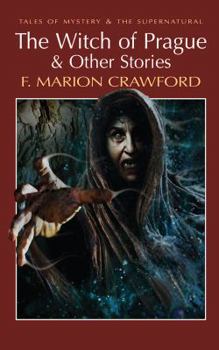The Witch of Prague & Other Stories
As I fell the thing sprang across me and seemed to throw itself upon the captain. When I last saw him on his feet his face was white and his lips set. It seemed to me that he struck a violent blow at... This description may be from another edition of this product.
Format:Paperback
Language:English
ISBN:1840220902
ISBN13:9781840220902
Release Date:July 2008
Publisher:Wordsworth Editions
Length:451 Pages
Weight:0.66 lbs.
Dimensions:1.0" x 4.9" x 7.7"
Customer Reviews
3 ratings
Victorian Era Horror
Published by Thriftbooks.com User , 14 years ago
These stories show their age, but are well written and mildly horrific in a staid Victorian way. If you like Saki or M. R. James then you should enjoy these stories ( a novella and several short stories including a horror classic, "The Upper Berth").
Cruel power, cruel powerlessness
Published by Thriftbooks.com User , 17 years ago
Crawford was an able novelist -- indeed, a very good novelist -- from the 19th century. He was a romanticist, best known for his series of Italian novels, starting with Saracinesca, one of his best books. He also wrote several fantasies, the best of them being Khaled: An Arabian Tale. This book, The Witch of Prague, is far more bizarre, a true work of a prolix and weird imagination. It is certainly not to everybody's taste. Many readers will find the author's tendency to wax eloquent on the culture and mindscape of his time, or the book's place (Prague), a bit tedious. I did not. Crawford may be, by contemporary standards, periphrastic; but by 19th century standards he was the very soul of concision. The characters are by no means realistic: they are romantic, gothic creations. The Wanderer, the central character, has no name throughout the novel; he is simply called The Wanderer. He is searching for his true love, Beatrice. He is captured by Unorna, the witch of the book's title. And he meets a wizard, Keyork Arabian, and Unorna's hapless suitor, Israel Kafka. At one point the witch places a spell on her admirer, using a scene from Czech history, that is so shocking that the author had to place a footnote at the beginning of the chapter to justify the inclusion of the incident. The event is doubly shocking today, since it could be so easily used by anti-Semites; but the author insists the referenced event -- the crucifiction, by his family, of a young Jewish convert to Christianity -- really did happen in the history of the city in question, Prague. The witchcraft of Unorna is mainly that of a super-mesmerism. She can instantly control people, and provide them with a completely altered sense of perception, even reality. But still, with all that power, she cannot have the man she wants. This is the moral heart of the book, and as such it places the book among the higher ranks of fantasy. Power is cruel. But powerlessness seems even more cruel, to her. (Note: this review is based on another edition of this book; I own only 19th century editions of this work, and cannot describe with accuracy the presentation or the included matter in the current edition.)
A Brilliant Classic of Occult Fiction!
Published by Thriftbooks.com User , 23 years ago
When a person is asked to describe a witch,the first image that comes to mind is an aged hag with a steeple crowned hat.However,this was not always the rule.The 'witch' in this tale is one such exception.Unorna,the witch is beautiful,with her red gold hair and her well proportioned features who resides in a mansion,and spends the winter in the huge conservatory surrounded by lofty palms and tropical plants.Her most remarkable feature is her eyes,which are of different colours and her ability to use them to hypnotise people and make them not only her slaves but to see what she wanted them to see or even forget their past.Despite her powers,she is not an inherently evil person but her love for the wanderer drives her to desperate measures to destroy her rival for his affections.She also has strange dealings with Keyork Arabian,who is attempting to prolong life through his experiments.This book might as well be called the Wizard rather than the Witch as Keyork Arabian is the most evil character in the book. This book is very interesting to read not only for the story and the marvellous descriptions but also for the author's in depth analysis of the powers of the human mind and her interpretation of the relation of the soul to the body.This is not a middle age romance as electricity is often mentioned in the book. A parallel can be drawn between this book and the classic by Gaston Leroux namely The Phantom of the Opera.Both the phantom and Unorna represent that part of us which seeks to be loved for ourselves and the great extent we can go in pursuance of that objective.Another similarity between the stories is that both characters have to make an important choice and redeem themselves by it.





